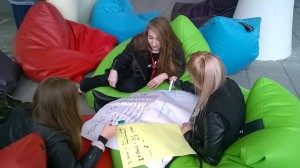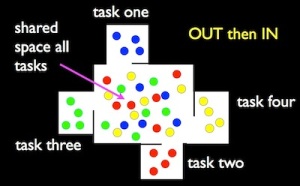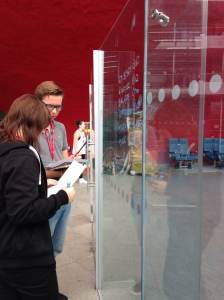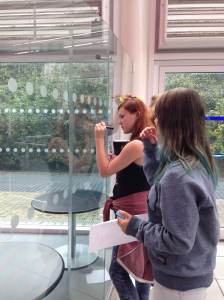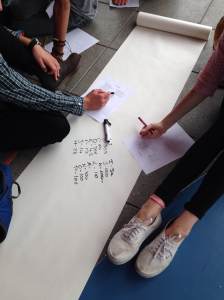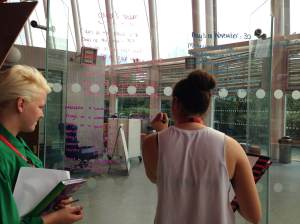The first MSI GEMS sessions took place today in all three Campuses. Students in Southend were in a very cold Atrium but kept warm by exercising their brains with Maths problems. Other students will be testing their skills throughout the week. Despite the cold the super classrooms were a hit.
Collaborative Group Based Learning – Beauty Level 2
Level 2 Beauty students had a lesson on reading comprehension & different reading strategies . This took place in the Super Classroom at Southend. It was a large class and the space enabled the learners to be split into smaller, manageable groups taking advantage of the open space.
It was interesting to observe how differently learners interacted with the different resources, using windows to respond to connect questions instead of post-it-notes. Reading tasks appeared to be far more engaging when bean bags were deployed to sit on. Equally the task of writing a set of instructions on how to complete a beauty application was executed collaboratively using large rolls of paper. This achieved the perfect opportunity for some peer assessment of both literacy skills and the knowledge learners had gained in beauty applications over the last couple of weeks of study.
Words for Work
Demonstrating the importance of Speaking and Listening communication skills in the workplace. http://www.literacytrust.org.uk/blog/5520_
Planning lessons for the superclass spaces
The following information has been taken from http://rubble.heppell.net/superclasses/ Stephen Heppell was just one point of inspiration for the GEMS Super Classroom initiative at South Essex College. Access his website for further inspiration for teaching and learning and different ways to try out the spaces.
Method (1) – A superclass can be also formed from a group of children coming together in a “commons” area to work autonomously on tasks given to them by different teachers in break-out spaces – in this OUT then IN version the tasks may be linked in some way and the teachers’ specialisms are the badges they wear: if you need help with the different components you seek the help of different teachers – again the parallel not serial principle applies.
Method (2) – A superclass can also be formed with a large all-together starting point in a commons area, with then students “breaking out” into surrounding spaces for different activities.
Reading & Research
Level 2 Art and Design students studying for their Functional Skills English qualifications had a lesson on reading & research techniques. It took place in the “Super Classroom” at the Southend campus.
The lesson was contextualised around the student’s design brief, currently being completed as part of their study programme. It included using documents about Picasso’s print making techniques to complete a skimming and scanning reading exercise and group reading on the graphic artist M.C. Escher.
 To connect to prior knowledge we used glass pens and the Atrium café windows, to brainstorm what and why we read to support studies in Art and Design. New information about reading techniques was presented to the class, and the entire atrium space was utilised as part of a matching exercise, introducing the definitions of skimming, scanning, sign-posting, purpose and audience. The reading exercises took place on the atrium bean bags and the relaxed, comfortable, open environment proved very engaging and effective. All groups extracted information collaboratively from their reading exercises on M.C. Escher, and created a wall of bullet points containing facts and opinions. They worked together to document the life, work and times of the artist. The work was photographed on Mobile Phones and Tablets, ready to record in sketchbooks and use for future research.
To connect to prior knowledge we used glass pens and the Atrium café windows, to brainstorm what and why we read to support studies in Art and Design. New information about reading techniques was presented to the class, and the entire atrium space was utilised as part of a matching exercise, introducing the definitions of skimming, scanning, sign-posting, purpose and audience. The reading exercises took place on the atrium bean bags and the relaxed, comfortable, open environment proved very engaging and effective. All groups extracted information collaboratively from their reading exercises on M.C. Escher, and created a wall of bullet points containing facts and opinions. They worked together to document the life, work and times of the artist. The work was photographed on Mobile Phones and Tablets, ready to record in sketchbooks and use for future research.
The lesson was described as “fun, active, exciting, different, relaxing, unexpected and interesting.”
Vectors can be fun!
I took a group of AS Physics students into the super classroom and we used the giant tape measures to walk real life vector addition problems. They used the directional compass apps on their phones to get the necessary directions then used each other as points of reference to map out the resultant vectors and measure the component parts. It was really fun, and although some struggled, some students were able to understand vectors better than they ever had before.
The launch of GEMS at Southend Campus!
The GEMS project has been launched across all three campuses! It is a great space where students can develop their English and Maths skills through active learning and a change of learning environment. It is also an area where English and Maths can be actively embedded into students vocational areas, as well in the wide world beyond college. The GEMS project is a brilliant opportunity to exemplify that after all, English and Maths skills are not only required in the classroom!
Media and Performing Arts – Maths Session
The Atrium at Southend
Media and Performing Arts students were the first to use the new GEMS space in Southend last week. Students were put into teams and were given a task in order to showcase their maths skills through completing an assumed knowledge quiz. Each team had a panel of glass outside the Atrium café and window marker pens, in order to present their answers and show their working. This allowed students to assess their peers and acquire knowledge of different methods of working out that they may not have used before.
Students used their answers in order to create their own maths problems relating to their vocational area, using imagery and visual aids in order to add an element of creativity.
Students felt that using the space allowed them to be creative with their maths and enjoyed working in the open space, whilst showcasing their vocational area to the rest of the college in the Atrium. The activity also created an element of competition amongst the teams which made for a great session!
Jade Riley – Functional Skills Lecturer

